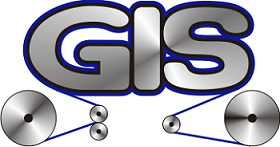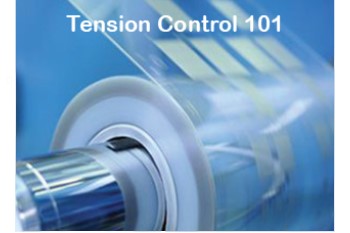Tension control and web handling are general terms. This blog is about the basics of tension control.
There is a simple formula: Tension = Torque / Radius.
The Tension is the force of the material as it goes through the tension zone. The Torque is the force applied to the roll or spool. The Radius is half the diameter of the roll. On an unwind, as the roll get smaller (the radius is decreasing), you must decrease the torque proportionally in order to maintain a constant tension.
There are three types of tension controls: manual, open loop, and closed loop.
Manual System Control
On a manual system, the torque is constant so the tension will rise as the diameter of the roll decreases. The control could be a power supply for a magnetic particle brake, a regulator for a pneumatic brake, or a leather strap or mechanical brake with a thumb knob. For some applications, this works fine.
Open Loop Control
On open loop control, there is a measurement for the diameter of the roll which can be achieved in a few different ways: diameter sensor (either laser or ultrasonic), follower arm, or a calculation from tachometer input from spindle and line speed. The diameter input is utilized by the control to send an output to the brake (torque) via an amplifier or current-to-pressure transducer. There is no feedback from the material which classifies the control as open loop. It automatically adjusts the torque as the roll gets smaller in order to maintain a fairly constant tension.
Closed Loop Control
There are two types of closed loop controls: dancer and load cell. In dancer control, the feedback comes from a potentiometer on the dancer arm. The proper way to load a dancer is with an air cylinder. The force on the dancer sets the tension. The control tries to maintain the position of the dancer arm. It will increase the brake if the dancer lowers and decrease the brake if the dancer rises. Dancers are great for intermittent motion, badly out of round rolls, and splicing on the fly. However, this type of closed loop does not allow for a read out in tension which is vital for precise tension control.
Our Favorite
By far the best tension control is utilizing closed loop load cell (tension sensors, tension transducers…) control. The load cell signal is utilized by the control to provide output to the brake via an amplifier or pneumatic converter. As mentioned previously, this is controlling the torque of the brake. The load cells will monitor the tension of the material which gives the operator a pound’s tension value to determine how the process is running. The control will maintain the set point tension by reducing the output to the brake as the roll gets smaller.
The Reasoning
Because of the set point and feedback from the load cell, this is the most stable and repeatable system for controlling tension on a web handling or continuous processing line.
Remember, this is tension control 101. There are many factors to determine the correct solution for each application. Luckily, Grosel Industrial Sales has over 40 years’ experience to assist. Please contact us with any questions.
Tags: Tension Control, Web Handling, Converting, Closed Loop Tension Control, Load Cells, Tension Transducers, Tension Sensors, Application Expertise, Grosel Industrial Sales

